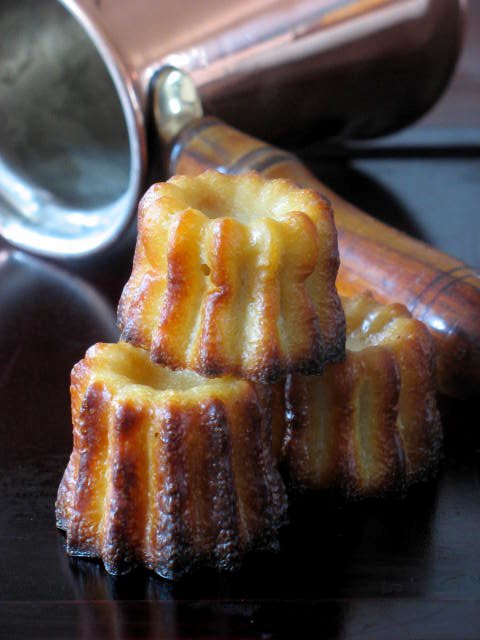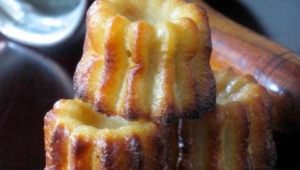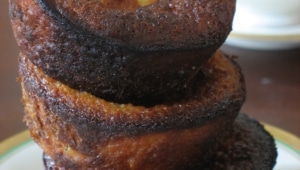
Actually, I am blaming Veronica for this week’s thigh expansion! You see, every Sunday I tutor her in French for an hour and we usually start our lesson with a rundown of the recipes we tried the past week and we end it with a exchange of the recipes we plan on trying. This past Sunday we prolonged the hour by talking baking resources online, utensils and molds. It reminded me of the silicone canneles molds my parents brought me last September that had not been used yet. Tragedy!!! So you all can guess what I did right after we said goodbye…and again the next night!
I blogged about Canneles last year when I could not wait to get the proper molds and decided to use muffin tins. The experience was successful, after all, appearances are one thing, taste is what matters. However, I could not resist their dainty cute shape and decided to rework the first recipe I made. They are a specialty from the South West town of Bordeaux, but you can bet that good as they are they finally made their way to most bakeries in France, especially Paris. When we were home last year, we got half a dozen (come on people, that’s three each! See, I can show restraint!!), from my favorite Patissier Gerard Mulot. I liked his a lot more than most I tried (and believe that for the sake of blogging I did try quite a many half dozen that time), because they retained their freshness the day after unlike most canneles out there. One characteristic of the canneles is that they crust while extremely buttery and crispy fresh from the oven will get moist and soft as the day goes by. Although I could eat an entire batch in one sitting, I was also attempting to share with the neighbors gathered on the patio! I suspected that a little bit more flour than usual would do the trick and I adapted the recipe accordingly. They were still best right out of the oven but even the next day, the moisture had not seeped out and the crust had remained beautifully crispy. Mission accomplished!
Most if not all pastry shops in France will coat the molds with beeswax as it does not burn at the high temperature they cook them in as fast as butter and sugar and gives the cakes a nice shiny crust. You can’t taste the beeswax at all, but I make canneles when the craving strikes me and I do not usually keep beeswax on hand, plus I was using silicone molds and not copper molds so I figured that part would not work the same! I reduced the oven temperature to avoid burning and bitter caramelization of the butter and sugar and that did the trick. I like canneles on the lighter color side, just my preference versus feeling like I am about to pop a morsel of coal in my mouth, but feel free to push the cooking time a little longer if you are so inclined. One last thing I strongly recommend is to refrigerate the batter at least 4-6 hours or to make it the night before. I started it at noon and we had them to go with coffee and cordials that evening. Funny thing is that I ran out of rum and used Calvados for the second batch…and people around me failed to understand the irony of making a Southern French treat with an alcohol from Normandy. Yes, I know, I am easily amused!
Makes 18 to 24 depending on your molds
750 milk (2 1/2 cups)
50 gr butter (2 TB)
3 eggs plus 3 egg yolks
200 gr granulated sugar (1 cup)
1 Tb vanilla extract
1/4 cup rum
155 gr flour (1 1/4 cups)
In a saucepan, bring the milk to a simmer, add the butter cut into dices. Mix well and let cool to lukewarm. In a bowl, mix the eggs, egg yolks, sugar and vanilla and whisk until foamy. Slowly add the rum and flour. Add the milk slowly and whisk until smooth. Pass it through a sieve if necessary. Let the batter rest in the fridge for a few hours or overnight. When the batter has rested, preheat the oven to 375F, position a rack in the center. Divide the batter evenly among the canneles molds, generously coated with cooking spray or well oiled if you use copper. Bake for 35-45 minutes. The will be scortching hot right out of the oven, so let them cool 20 minutes or so before enjoying them.
Note about the molds:
Last time they came my parents brought many of my favorite Demarle silicone pans (a bit pricey but so worth it) as well as a couple others they did not have on stock, called Moulflex, cheaper, bright red and a little bit lighter. I was skeptical but grateful at the same time as I did not want to pay for copper canneles molds…Oh trust me I could…they are so pretty and shiny…but I can’t justify such an expense to my beloved! The Moulflex ones worked like a charm! The only copper thing I owned is the hot chocolate pot in the top picture that I found at an antique store.




